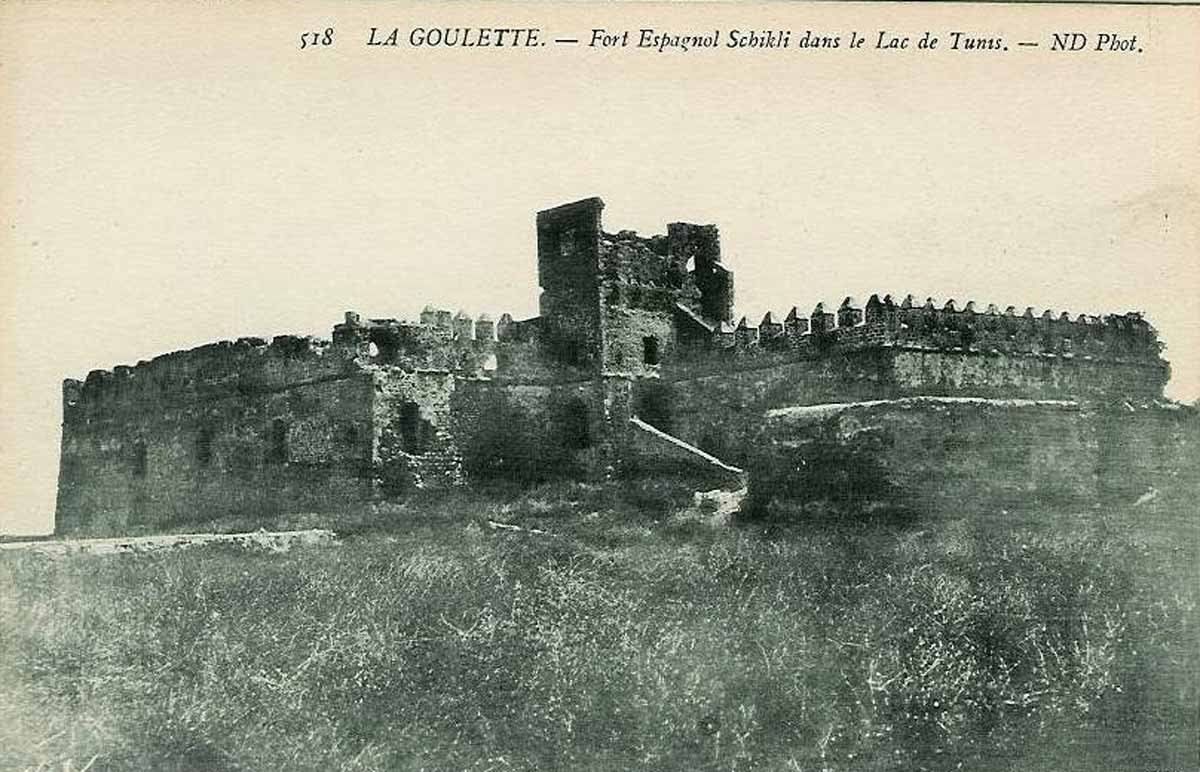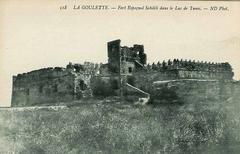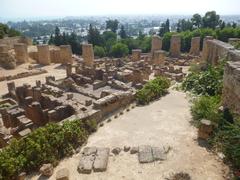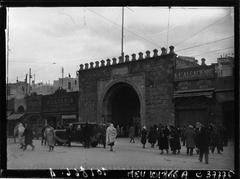
Fort Santiago Chikly Visiting Hours, Tickets & Historical Sites Guide in Tunis Governorate, Tunisia
Date: 14/06/2025
Introduction
Fort Santiago Chikly, located on the secluded îlot Chikly in Lake Tunis, is a testament to Tunisia’s complex heritage and ecological significance. This fortress, with roots dating back to the Roman and Byzantine eras, has witnessed Spanish and Ottoman reconstructions, serving over centuries as a military bastion, prison, hospital, and quarantine station (archiqoo.com; MedWetCulture; MappingMENA). Beyond its historical narrative, Fort Santiago Chikly is surrounded by Lake Tunis—a Ramsar wetland and IUCN Category IV protected area—home to diverse flora and fauna, including significant bird colonies (MedWetCulture; Carthage Magazine).
Visitors today can explore Renaissance fortifications, Roman mosaics, and Ottoman adaptations, while enjoying breathtaking lake views. Access is by boat from La Goulette harbor, and guided tours are available to enrich the experience. Pair your visit with other prominent Tunis sites such as Carthage, the Medina of Tunis, and the Bardo National Museum (INP; Tunisia Tourism; tunisie.co). This guide delivers all practical information on visiting hours, ticketing, accessibility, and conservation, helping you make the most of your journey to this unique heritage site (Evendo).
Table of Contents
- Historical Background
- Visiting Fort Santiago Chikly: Practical Information
- Architectural and Archaeological Highlights
- Conservation Status and Future Prospects
- FAQs
- Useful Links and References
Historical Background
Roman and Byzantine Foundations
Fort Santiago Chikly’s origins trace to the late Roman Empire in the 4th century AD, when it functioned as a strategic military outpost protecting routes to ancient Carthage and Tunis (archiqoo.com). Archaeological excavations have revealed Roman structural remains and mosaics with characteristic geometric patterns. The site’s military role continued into the Byzantine era, with reinforced walls and reused Roman materials reflecting the ongoing need to defend this vital approach (tunisie.co).
Spanish Reconstruction and Ottoman Modifications
The fort underwent major changes after the Spanish conquest of Tunis in 1535. Rebuilt between 1546 and 1550, it was renamed Fort Santiago and featured star-shaped bastions and artillery platforms, marking a shift to Renaissance military architecture. The Ottomans recaptured Tunis later that century, and in 1660, Dey Hadj Mustapha Laz oversaw further upgrades, adapting the fort to Ottoman needs while preserving its Spanish essence (archiqoo.com).
Decline and Abandonment
As military technologies evolved and priorities shifted, Fort Santiago Chikly gradually lost importance. By 1830, it was abandoned and left to deteriorate, largely forgotten by the local population (tunisie.co).
Rediscovery, Restoration, and Modern Significance
Cultural revival began in the early 20th century with cultural events organized by Albert Samama-Chikli. Official recognition as a national heritage site came in 1993, sparking Tunisian-Spanish restoration efforts. Archaeological digs unearthed mosaics, coins, and artifacts from the Roman, Byzantine, Spanish, and Ottoman periods, underscoring the fort’s multi-layered past (archiqoo.com). Though still relatively unknown, Fort Santiago Chikly stands as a symbol of Tunisia’s crossroads of civilizations.
Visiting Fort Santiago Chikly: Practical Information
Visiting Hours and Ticketing
- Hours: Typically open Tuesday through Sunday, 9:00 AM–5:00 PM. Closed Mondays and public holidays. Hours may vary for restoration or conservation needs—check official sources before visiting.
- Tickets: Entry requires advance booking due to conservation regulations and limited capacity. Tickets are available online or via authorized tour operators. Standard fees range from 10 to 20 TND (approx. 3–6 USD), with discounts for students and seniors (INP).
- Group Visits: The daily visitor cap is about 20 people, often divided into two groups to minimize environmental impact (WIT Press).
Accessibility and Getting There
- Access: Chikly Island is reachable only by boat, usually departing from La Goulette or lakeside docks near central Tunis. Boat transfers are managed by tour operators or during official events (Tunisia Tourism).
- Mobility: The island and fort terrain involve uneven surfaces and steps; accessibility for visitors with mobility challenges is limited. Contact organizers in advance for assistance.
- Getting There: Arrive at departure points by taxi or public transport; parking is available near most docks.
Guided Tours, Travel Tips, and Nearby Attractions
- Guided Tours: Tours are highly recommended and often required, providing in-depth historical and ecological context. Available in Arabic, French, and occasionally English.
- Travel Tips: Wear sturdy footwear, bring sun protection, water, and snacks. Plan for 2–3 hours including transfers.
- Nearby Attractions: Combine your visit with the Medina of Tunis, Bardo National Museum, Carthage ruins, and Sidi Bou Said for a well-rounded cultural itinerary.
Architectural and Archaeological Highlights
Fort Santiago Chikly is a unique blend of Roman, Byzantine, Spanish, and Ottoman influences. Key features include:
- Star-shaped Bastions: Exemplify Renaissance military engineering.
- Archaeological Finds: Roman and Byzantine mosaics, Islamic ceramics, Spanish military artifacts.
- Watchtowers and Courtyard: Offer panoramic lake views and display interpretive panels on site history (archiqoo.com).
The fort’s restoration preserved these elements and revealed artifacts now displayed during special exhibitions and tours.
Conservation Status and Future Prospects
Current Conservation
Fort Santiago Chikly and Chikly Island hold protected status as national heritage and ecological sites (Carthage Magazine). The site is managed by the Ministry of Culture and National Heritage Institute with support from Spanish partners and academic institutions (WIT Press).
Key Conservation Measures:
- Limited daily visitor numbers to reduce ecological impact.
- Ongoing monitoring of the fort’s structural integrity.
- Protection of the island’s significant egret colony and other wildlife.
- Continued archaeological research and digital engagement, including virtual tours (Evendo).
Challenges and the Future
- Environmental Risks: Pollution, climate change, and human disturbance threaten both the structure and ecosystem.
- Sustainable Tourism: Future plans focus on low-impact visits, educational programs, and community engagement to balance public access with preservation (Tunisie.co).
FAQs
Q: What are Fort Santiago Chikly’s visiting hours?
A: Tuesday through Sunday, 9:00 AM to 5:00 PM. Verify before your visit for seasonal changes.
Q: How do I buy tickets?
A: Purchase in advance via official tourism portals or authorized tour operators; on-site sales are rare.
Q: Is the island accessible for people with disabilities?
A: Accessibility is limited due to the terrain and boat access; contact organizers for assistance.
Q: Are guided tours available?
A: Yes, and they are strongly recommended or required for most visits.
Q: What should I bring?
A: Comfortable shoes, sun protection, water, snacks, cash (TND), and any personal medications.
Q: What other historical sites are nearby?
A: Explore the Medina of Tunis, Bardo Museum, Carthage ruins, and Sidi Bou Said.
Useful Links and References
- Fort Santiago Chikly: Visitor’s Guide (Archiqoo)
- Lake Tunis and Chikly Wetlands (MedWetCulture)
- Institut National du Patrimoine (INP)
- Tunisia Tourism Official Site
- Carthage Magazine: Fort Santiago Chikly
- WIT Press: Conservation Research
- Evendo: Fort Santiago Chikly Virtual Tour
- BirdLife International: Tunisian Wetlands
Final Tips
Fort Santiago Chikly offers a rare fusion of history, architecture, and nature in the heart of Lake Tunis. Ensure a smooth visit by booking ahead, respecting conservation guidelines, and integrating nearby attractions into your itinerary. Take advantage of downloadable guides and apps for an enhanced experience, and follow official channels for updates on special events and restoration progress.
Your responsible visit supports the preservation of this extraordinary monument for generations to come.


